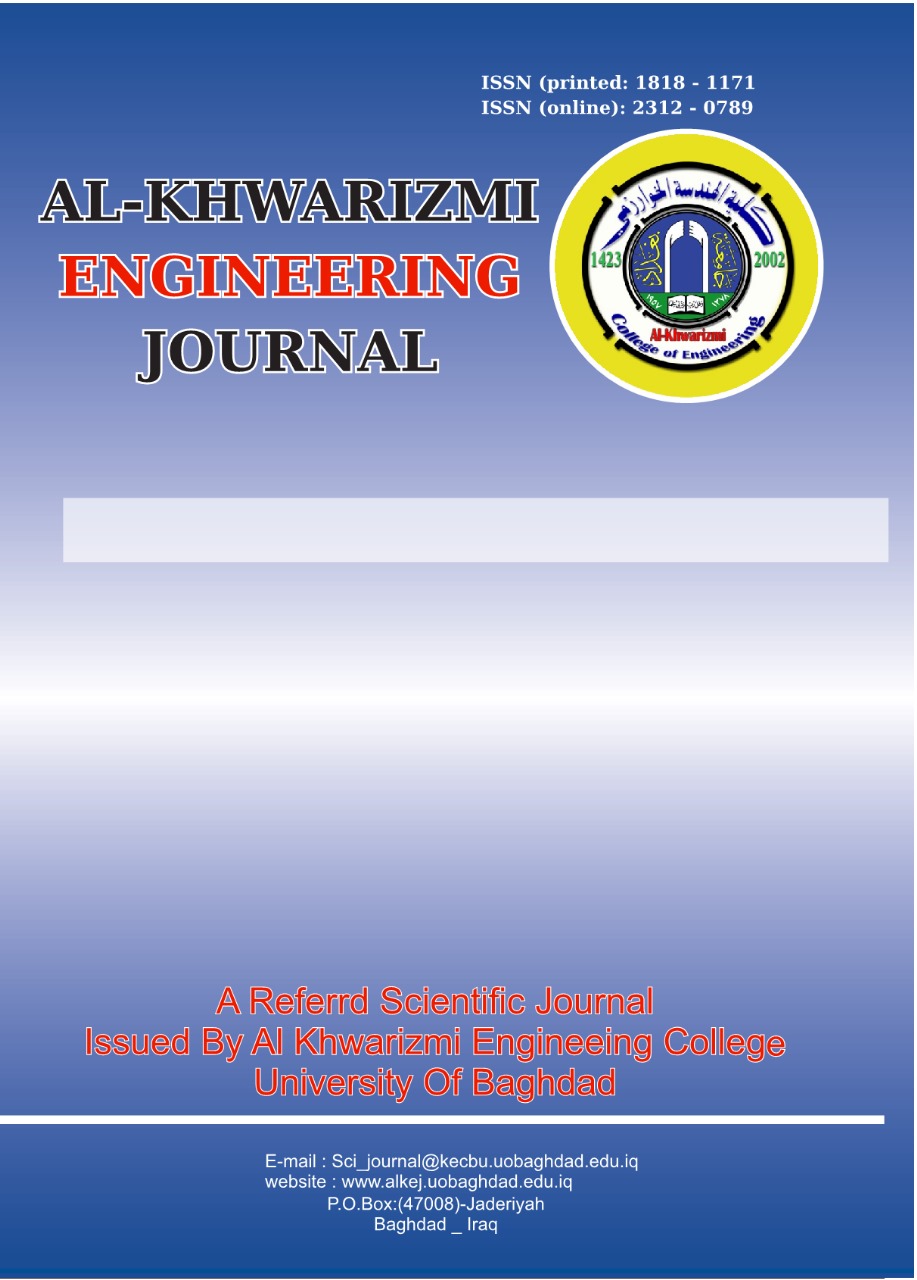تطبيق النظام المائي ثنائي الطور في استخلاص إنزيم الإنفرتيز من درنات البطاطس باستخدام PEG8000/فوسفات البوتاسيوم
DOI:
https://doi.org/10.22153/kej.2025.11.003الكلمات المفتاحية:
Aqueous two-phase system, Enzymes, plant source, Potato tuber.الملخص
يعد النظام المائي ثنائي الطور (ATPS) بديلاً نظيفًا لأنظمة استخلاص مذيبات المياه العضوية التقليدية. أثبتت هذه التقنية فعاليتها العالية في استخلاص وفصل مخاليط الجزيئات الحيوية. تضمن البحث الحالي استخلاص إنزيم الإنفرتيز من درنات البطاطس باستخدام ATPS . النظام المطبق هو: البولي إيثيلين جلايكول 8000 مع ثنائي فوسفات البوتاسيوم (PEG8000/PPH) . بحثت الدراسة في تأثير خمسة عوامل وهي درجة الحرارة، وتركيز PEG8000، وتركيز فوسفات ثنائي البوتاسيوم، والأس الهيدروجيني، وإضافة كلوريد الصوديوم (NaCl) أو كبريتات المغنيسيوم (MgSO4) كمحفز، على نسبة الاسترداد (%Rec) ومعاملال الفصل (KE) لإنزيم الإنفرتيز في ATPS . خلال فترة الدراسة حقق النظام اعلى قدر من الأسترجاع (%Rec) بنسبة 87.52% واعلى معامل فصل (KE) قدره 7.01 عند درجة حرارة 10 درجات مئوية، مع تركيز PEG8000 قدره 1.5 جم/10 مل، وتركيز فوسفات ثنائي البوتاسيوم 2.4 جم/ 10 مل، ودرجة حموضة 10. بعد إضافة الأملاح المحايدة، حقق النظام اعلى نسبة استرداد %Rec وقدره 91.9% واعلى قيمة لمعامل الفصل KE وقدره 11.34 في ظل نفس الظروف المثالية، وتركيز MgSO4 قدره 1 جم/10 مل.
التنزيلات
المراجع
[1] Albertsson P. Å.: Partition of Cell Particles and Macromolecules in Polymer Two-Phase Systems. Advances in protein chemistry, vol. 24, pp. 309-341 (1970) https://doi.org/10.1016/S0065-3233(08)60244-2
[2] Grilo A. L., Raquel Aires-Barros M. and Azevedo A. M.: Partitioning in Aqueous Two-Phase Systems: Fundamentals, Applications and Trends. Separation & Purification Reviews, vol. 45, pp. 68-80 (2016) doi: 10.1080/15422119.2014.983128
[3] Hatti-Kaul R. , "Aqueous two-phase systems: methods and protocols," Springer Science & Business Media, vol. 11 (2008)
[4] Iqbal M., Tao Y., Xie S., Zhu Y., Chen D. and Yuan Z.: Aqueous two-phase system (ATPS): an overview and advances in its applications," Biological procedures online, vol. 18, pp. 1-18 (2016)
[5] Asenjo J. A. and Andrews B. A.: Aqueous two-phase systems for protein separation: A perspective. Journal of Chromatography A 1218, vol. 49, pp. 8826-8835 (2011) doi: 10.1016/j.chroma.2011.06.051
[6] Mendes, M.S., Rosa, M.E., Ramalho, F., Freire, M.G. and e Silva, F.A..: Aqueous two-phase systems as multipurpose tools to improve biomarker analysis. Separation and Purification Technology, p.123875. (2023) https://doi.org/10.1016/j.seppur.2023.123875
[7] Mahdi, H. A., Hameed, K. W., & Ali, A. J. A. (2023). Extraction of Bovine Serum Albumin by Aqueous Two-Phase System Using PEG4000/Sodium Citrate and PEG8000/Sodium Phosphate. Al-Khwarizmi Engineering Journal, 19(2), 39-51.) https://doi.org/10.22153/kej.2023.04.001
[8] Molino J. V. D., Marques D. D. A., Júnior A. P., Mazzola P. G. and Gatti M. S. V.: Different types of aqueous two-phase systems for biomolecule and bioparticle extraction and purification. Biotechnology Progress, vol. 29, pp. 1343-1353 (2013)
[9] Teixeira A. G., Agarwal R., Ko K. R., Grant‐Burt J., Leung B. M. and Frampton J. P.: Emerging biotechnology applications of aqueous two‐phase systems. Advanced healthcare materials, vol. 7, p. 1701036 (2018) doi: 10.1002/adhm.201701036
[10] Mohammed W.T., and Mahdi A.S.: Liquid-Liquid Extraction of Metal Ions Using Aqueous Biphasic Systems. Journal of Engineering, 18(09), pp.989-998, (2012).
[11] Shahbazova, G.M. and Masimov, E.A.: Effect of a Various Additivies to the Formation of Aqueous Biphasic System Polyetylenglycole (Peg)/Sodium Citrate/Water. Open Access Library Journal, 9(1), pp.1-9. (2022) DOI: 10.4236/oalib.1108142
[12] Yau Y. K., Ooi C. W., Ng E. P., Lan J. C. W., Ling T. C. and Show P. L.: Current applications of different type of aqueous two-phase systems. Bioresources and Bioprocessing, vol. 2, pp. 1-13 (2015) doi: 10.1186/s40643-015- 0078-0
[13] Pereira J. F., Freire M. G. and Coutinho J. A.: Aqueous two-phase systems: Towards novel and more disruptive applications. Fluid Phase Equilibria, vol. 505, p. 112341 (2020) doi: 10.1016/j.fluid.2019.112341
[14] Kulshrestha S., Tyagi P., indhi V. and Yadavilli K. S.: Invertase and its applications–a brief review. Journal of pharmacy research, vol. 7, pp. 792-797 (2013) https://doi.org/10.1016/j.jopr.2013.07.014
[15] Bagal D. S., Vijayan A., Aiyer R. C. Karekar R. N. and Karve M. S.: Fabrication of sucrose biosensor based on single mode planar optical waveguide using co-immobilized plant invertase and GOD. Biosensors and Bioelectronics, vol. 22, pp. 3072-3079 (2007).
[16] Kumar S., Chauhan V. S. and Nahar P.: Invertase embedded-PVC tubing as a flow-through reactor aimed at conversion of sucrose into inverted sugar. Enzyme and microbial technology, vol. 43, pp. 517-522 (2008) DOI: 10.1016/j.enzmictec.2008.08.002
[17] Ahiakpa, J.K., Karikari, B., Magdy, M., Munir, S., Mumtaz, M.A., Li, F., Wang, Y., Shang, L. and Zhang, Y., Regulation of invertase and sucrose for improving tomato fruit flavor: A review. Vegetable Research, 1(1), pp.1-13 (2021) https://doi.org/10.48130/VR-2021-0010
[18] Lee H. S. and Sturm A.: Purification and characterization of neutral and alkaline invertase from carrot. Plant Physiology, vol. 112, pp. 1513-1522 (1996) https://doi.org/10.1104/pp.112.4.1513
[19] Liu C. C., Huang L. C., Chang C. T. and Sung H. Y.: Purification and characterization of soluble invertases from suspension-cultured bamboo (Bambusa edulis) cells. Food chemistry, vol. 96, pp. 621-631 (2006)
[20] Madhusudhan M. C. and Raghavarao K. S. M. S.: Aqueous two phase extraction of invertase from baker's yeast: Effect of process parameters on partitioning. Process biochemistry, vol. 46, pp.2014-2020 (2011) doi:10.1016/j.foodchem.2005.02.044
[21] Andjelković U., Pićurić S. and Vujčić Z.: Purification and characterisation of Saccharomyces cerevisiae external invertase isoforms. Food Chemistry, vol. 120, pp. 799-804 (2010) doi:10.1016/j.foodchem.2009.11.013
[22] Nadeem, H., Rashid, M.H., Siddique, M.H., Azeem, F., Muzammil, S., Javed, M.R., Ali, M.A., Rasul, I. and Riaz, M.: Microbial invertases: a review on kinetics, thermodynamics, physiochemical properties. Process Biochemistry. 50(8), pp.1202-1210 (2015) http://dx.doi.org/10.1016/j.procbio.2015.04.015
[23] Rodriguez J., Perez J. A., Ruiz T. and Rodriguez L.: Characterization of the invertase from Pichia anomala. Biochemical journal, vol. 306, pp. 235-239 (1995) https://doi.org/10.1042/bj3060235
[24] Nguyen Q. D., Rezessy-Szabó J. M., Bhat M. K. and Hoschke Á.: Purification and some properties of β-fructofuranosidase from Aspergillus niger IMI303386. Process Biochemistry, vol. 40, pp. 2461-2466 (2005) DOI:10.1016/J.PROCBIO.2004.09.012
[25] Valencia-Hernández, L.J., Wong-Paz, J.E., Ascacio-Valdés, J.A., Contreras-Esquivel, J.C., Chávez-González, M.L., Martínez-Pérez, A., Castillo-Olvera, G. and Aguilar, C.N.: Kinetic study of fungal growth of several tanninolytic strains using coffee pulp Procyanidins. Fermentation, 8(1), p.17 (2021) https://doi.org/10.3390/fermentation8010017
[26] Sturm A.: Primary structures, functions, and roles in plant development and sucrose partitioning. Plant physiology, vol. 121, pp. 1-8 (1999) https://doi.org/10.1104/pp.121.1.1
[27] Draffehn A. M., Meller S., Li L. and Gebhardt C.: Natural diversity of potato (Solanum tuberosum) invertases. BMC Plant Biology, vol. 10, pp. 1-15 (2010) doi:10.1186/1471-2229-10-271
[28] Zhang K, Wu Z, Wu X, Han H, Ju X, Fan Y, Yang C, Tang D, Cao Q, Wang J, Lv C.: Regulatory and functional divergence among members of Ibβfruct2, a sweet potato vacuolar invertase gene controlling starch and glucose content. Frontiers in Plant Science 14, 1192417 (2023) https://doi.org/10.3389/fpls.2023.1192417
[29] Li R, Li J, Liao X, Wang Y.: Purification and characterisation of soluble acid invertase from mango fruits. International Journal of Food Science & Technology. Apr;52(4): 906-15 (2017) https://doi.org/10.1111/ijfs.13354
[30] Gan Q, Li X, Zhang X, Wu L, Ye C, Wang Y, Gao J, Meng Y.: D181A site-mutagenesis enhances both the hydrolyzing and transfructosylating activities of BmSUC1, a novel β-fructofuranosidase in the silkworm Bombyx mori. International Journal of Molecular Sciences. Feb 28;19(3):683 (2018) https://doi.org/10.3390/ijms19030683
[31] Fisher, D.: The separation of cells and organelles by partitioning in two-polymer aqueous phases. Biochemical Journal, 196(1), p.1. (1981) doi: 10.1042/bj1960001
[32] Raja S., Murty V. R., Thivaharan V., Rajasekar V. and Ramesh V.: Aqueous two phase systems for the recovery of biomolecules–a review. Science and Technology, vol. 1, pp. 7-16 (2011) doi: 10.5923/j.scit.20110101.02.
[33] Pressey, R., 1967. Invertase inhibitor from potatoes: purification, characterization, and reactivity with plant invertases. Plant Physiology, 42(12), pp.1780-1786.
[34] Yuzugullu, Y. and Duman, Y.A., 2015. Aqueous two-phase (PEG4000/Na2SO4) extraction and characterization of an acid invertase from potato tuber (Solanum tuberosum). Preparative Biochemistry and Biotechnology, 45(7), pp.696-711.
[35] Duman, Y. and Kaya, E., 2014. Purification and recovery of invertase from potato tubers (Solanum tuberosum) by three phase partitioning and determination of kinetic properties of purified enzyme. Turkish Journal of Biochemistry/Turk Biyokimya Dergisi, 39(4).
[36] Mohd Salleh, M.H., Fitri Peli, A., Ngalimat, M.S. and Sim, K.J.: A mini literature review on current advancements in protein purification techniques. In Biology and Life Sciences Forum Vol. 20, No. 1, p. 12 (2022) https://doi.org/10.3390/IECBM2022-13507
[37] Mendes, M.S., Rosa, M.E., Ramalho, F., Freire, M.G. and e Silva, F.A.: Aqueous two-phase systems as multipurpose tools to improve biomarker analysis. Separation and Purification Technology, p.123875 (2023) https://doi.org/10.1016/j.seppur.2023.123875
[38] Sripokar, P., Chaijan, M., Benjakul, S., Yoshida, A. and Klomklao, S.: Aqueous two-phase partitioning of liver proteinase from albacore tuna (Thunnus alalunga): application to starry triggerfish (Abalistes stellaris) muscle hydrolysis. International journal of food properties, 20(sup2), pp.1600-1612 (2017) https://doi.org/10.1080/10942912.2017.1350705
[39] Gandolfi, O.R.R., de Sousa Castro, S., Gonçalves, G.R.F., Muniz, I.D.C.B., Fontan, R.D.C.I., Pimentel, J.G. and Bonomo, R.C.F.: Thermodynamic modelling of the partitioning of lysozyme in aqueous two-phase systems composed of polyethylene glycol and salt at different temperatures. Chemical Engineering Journal Advances, 16, p.100556 (2023) https://doi.org/10.1016/j.ceja.2023.100556
[40] Da Silva, C.A.S., Coimbra, J.D.R., Rojas, E.E.G. and Teixeira, J.A.C.: Partitioning of glycomacropeptide in aqueous two-phase systems. Process Biochemistry, 44(11), pp.1213-1216 (2009) https://doi.org/10.1016/j.procbio.2009.06.016
[41] Miller, G. L. (1959). Use of dinitrosalicylic acid reagent for determination of reducing sugar. Analytical chemistry, 31(3), 426-428.
[42] Karkaş T. and Önal S.: Characteristics of invertase partitioned in poly (ethylene glycol)/magnesium sulfate aqueous two-phase system. Biochemical Engineering Journal, vol. 60, pp. 142-150 (2012) https://doi.org/10.1016/j.bej.2011.11.005
[43] Jaffer, Z.M., Hameed, K.W. and Imran, S.G.: February. Extraction of prodigiosin using aqueous two phase system. In IOP Conference Series: Materials Science and Engineering (Vol. 1076, No. 1, p. 012026). IOP Publishing (2021) DOI 10.1088/1757-899X/1076/1/012026
[44] Gusakov, A.V., Kondratyeva, E.G. and Sinitsyn, A.P.: Comparison of two methods for assaying reducing sugars in the determination of carbohydrase activities. International journal of analytical chemistry, (2011) https://doi.org/10.1155/2011/283658
[45] Lowry O. H., Rosebrough N. J., Farr A. L. and Randall R.: Protein measurement with the Folin phenol reagent. J biol Chem, vol. 193, pp. 265-275 (1951)
[46] Chugh, V., Kaur, N., Gupta, A.K. and Rai, A.: The seed biochemical signature as a potent marker for water logging tolerance in maize. Plant Stress, 4, p.100085 (2022) https://doi.org/10.1016/j.stress.2022.100085
[47] Krishnan, H.B.; Blanchette, J.T;, Okita, T.W. Characterization of cell wall-bound and soluble forms. Plant Physiol. 1985, 78, 241–245. 39.
[48] Singh, M.B., Knox, R.B. Characterization and activity during in vitro germination. Plant Physiol. 1984, 74, 510–515. 40.
[49] Topcu, H., Degirmenci, I., Sonmez, D. A., Paizila, A., Karci, H., Kafkas, S., & Alatawi, A. (2022). Sugar, invertase enzyme activities and invertase gene expression in different developmental stages of strawberry fruits. Plants, 11(4), 509.
[50] Yuzugullu, Y., & Duman, Y. A. (2015). Aqueous two-phase (PEG4000/Na2SO4) extraction and characterization of an acid invertase from potato tuber (Solanum tuberosum). Preparative Biochemistry and Biotechnology, 45(7), 696-711.
[51] Hutin, A., 2022. Difference between isoelectric point (IEP), point of zero charge (PZC), and isoionic point (IIP). The little corner of science: Vol. Application Notes φ-χ: Theory (1.0). Zenodo, pp.1-5 DOI: 10.5281/zenodo.6346860
[52] Mahdi, H. A., Hameed, K. W., & Ali, A. J. A. (2023). Application of Aqueous Two-Phase Systems in the Extraction of Bovine Serum Albumin. Journal of Polymer & Composites, 11(1), 55-65p.
[53] Saravanan, S., Rao, J.R., Nair, B.U. and Ramasami, T., 2008. Aqueous two-phase poly (ethylene glycol)–poly (acrylic acid) system for protein partitioning: Influence of molecular weight, pH and temperature. Process biochemistry, 43(9), pp.905-911. DOI: 10.1016/j.procbio.2008.04.011
[54] Kee, P. E., Lan, J. C. W., Yim, H. S., Chow, Y. H., Chen, P. T., & Ng, H. S. (2021). Efficiency of polymer/salt aqueous two-phase electrophoresis system for recovery of extracellular Kytococcus sedentarius TWHKC01 keratinase. Process Biochemistry, 100, 199-206.
[55] Johansson, G. (1985). Aqueous two-phase systems in protein purification. Journal of biotechnology, 3(1-2), 11-18.
[56] Raja, S., Murty, V. R., Thivaharan, V., Rajasekar, V., & Ramesh, V. (2011). Aqueous two phase systems for the recovery of biomolecules–a review. Sci Technol, 1(1), 7-16.
[57] Shad Z, Mirhosseini H, Hussin ASM, Forghani B, Motshakeri M, Manap MYA. Aqueous twophase purification of α-Amylase from white pitaya (Hylocereus undatus) peel in polyethylene glycol/citrate system: Optimization by response surface methodology. Biocatal Agric Biotechnol [Internet]. 2018; 14: 305–13. Available from: https://doi.org/10.1016/j.bcab.2018.01.014
التنزيلات
منشور
إصدار
القسم
الرخصة
الحقوق الفكرية (c) 2025 مجلة الخوارزمي الهندسية

هذا العمل مرخص بموجب Creative Commons Attribution 4.0 International License.
حقوق الطبع والنشر: يحتفظ مؤلفو الوصول المفتوح بحقوق الطبع والنشر لاعمالهم، ويتم توزيع جميع مقالات الوصول المفتوح بموجب شروط ترخيص Creative Commons Attribution License، والتي تسمح بالاستخدام غير المقيد والتوزيع والاستنساخ في أي وسيط، بشرط ذكر العمل الأصلي بشكل صحيح. إن استخدام الأسماء الوصفیة العامة، والأسماء التجاریة، والعلامات التجاریة، وما إلی ذلك في ھذا المنشور، حتی وإن لم یتم تحدیدھ بشکل محدد، لا یعني أن ھذه الأسماء غیر محمیة بموجب القوانین واللوائح ذات الصلة. في حين يعتقد أن المشورة والمعلومات في هذه المجلة صحيحة ودقيقة في تاريخ صحتها، لا يمكن للمؤلفين والمحررين ولا الناشر قبول أي مسؤولية قانونية عن أي أخطاء أو سهو قد يتم. لا يقدم الناشر أي ضمان، صريح أو ضمني، فيما يتعلق بالمواد الواردة في هذه الوثيقة.















